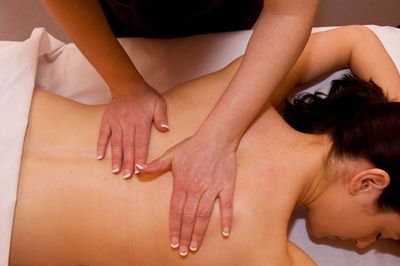Massage Treatments
What is massage therapy?
Massage is a "hands on" treatment in which a therapist manipulates muscles and other soft tissues of the body to improve health and well being. Varieties of massage range from gentle stroking and kneading of muscles and other soft tissues to deeper manual techniques. Massage has been practiced as a healing therapy for centuries in nearly every culture around the world.
It helps relieve muscle tension, reduce stress, and evoke feelings of calmness. Although massage affects the body as a whole, it particularly influences the activity of the musculoskeletal, circulatory, lymphatic, and nervous systems.

Are there many types of massage?
There are nearly 100 different massage and body work techniques. Each technique is uniquely designed to achieve a specific goal. The most common types practiced include:
- Aromatherapy massage: Essential oils from plants are massaged into the skin to enhance the healing and relaxing effects of massage. Essential oils are believed to have a powerful effect on mood by stimulating two structures deep in the brain known to store emotions and memory.
- Craniosacral massage: Gentle pressure is applied to the head and spine to correct imbalances and restore the flow of cerebrospinal fluid in these areas.
- Indian Head Massage: An ancient healing system practiced all over India for thousands of years. The head holds many pressure points relating to the rest of the body and particularly to emotional centers in the brain.
- Lymphatic massage: Light, rhythmic strokes are used to improve the flow of lymph (colorless fluid that helps fight infection and disease) throughout the body. One of the most popular forms of lymphatic massage, manual lymphatic drainage (MLD), focuses on draining excess lymph.
- Myofascial release: Gentle pressure and body positioning are used to relax and stretch the muscles, fascia (connective tissue), and related structures. Trained physical therapists and massage therapists use this technique.
- Reflexology: Specialized thumb and finger techniques are applied to the hands and feet. Reflexologists believe that these areas contain "reflex points," or direct connections to specific organs and structures, throughout the body.
- Sports massage: Often used on professional athletes and other active individuals, sports massage can enhance performance and prevent or treat sports related injuries.
- Swedish massage: A variety of strokes and pressure techniques are used to enhance the flow of blood to the heart, remove waste products from the tissues, stretch ligaments and tendons, and ease physical and emotional tension.
Tell your massage therapist about any medications you are taking, as massage may influence absorption or activity of both oral and topical medications.
